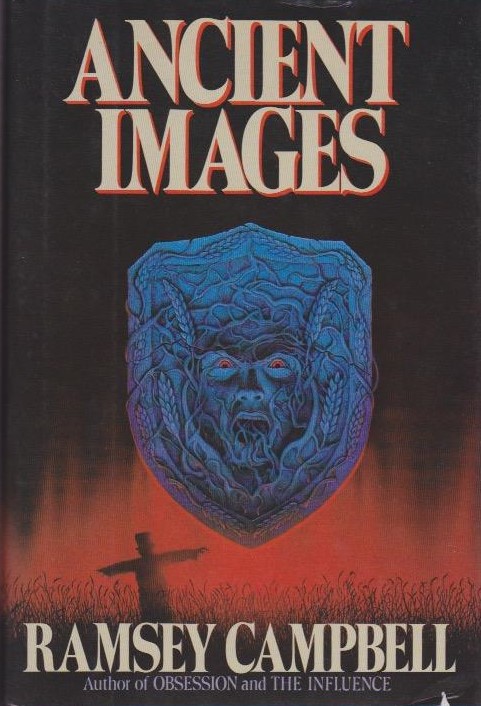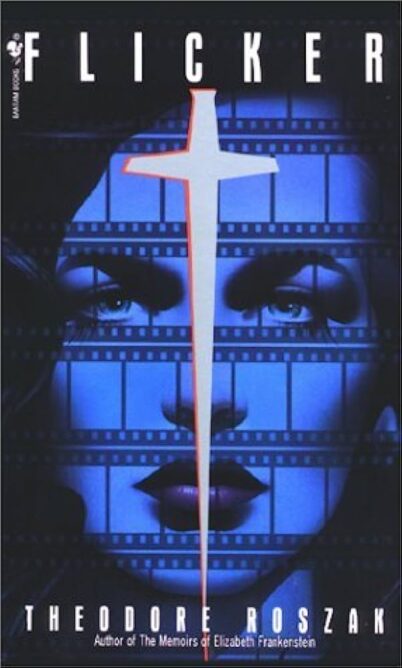I’ve always believed that in the category of movie-themed fiction horror is the ideal genre. Let’s go back to some of the earliest examples of novels about moviemaking, such as QUEER PEOPLE by Carroll and Garrett Graham and THE DAY OF THE LOCUST by Nathaniel West, which are both quite horrific in their way, as are WHAT MAKES SAMMY RUN? by Budd Schulberg and THE WOMAN CHASER by Charles Willeford. There’s something about moviemaking, and its attendant networking and publicity, that clicks with the cynicism of QUEER PEOPLE and THE DAY OF THE LOCUST, and the sociopathic personality studies of WHAT MAKES SAMMY RUN? and THE WOMAN CHASER.
Then we have the more traditional horrors contained in movie-themed publications like THE LATE GREAT CREATURE by Brock Brower, PSYCHO II by Robert Bloch (quite different from the 1983 movie of that title), CRIMSON ORGY by Austin Williams and, foremost of all, FLICKER by the late Theodore Roszak (1933-2011). The latter novel, published in 1991, can be considered the ultimate horrific fictional extrapolation on all things filmic, but it doesn’t have the field to itself. The similarly oriented ANCIENT IMAGES by the prolific Ramsey Campbell preceded Roszak’s masterpiece by two years, and while it doesn’t better FLICKER by any means (or Campbell’s later film-themed novel THE GRIN OF THE DARK), ANCIENT IMAGES can’t be dismissed.
ANCIENT IMAGES was bookended by MIDNIGHT SUN and THE COUNT OF ELEVEN, in my view two of Campbell’s better efforts. ANCIENT IMAGES may not rise to their level, but it contains many Campbell trademarks, including superbly evocative, oft-hallucinatory prose and a good eye for telling detail (this is a rare novel that dramatizes its heroine’s menstruation). It boasts a compelling narrative built around the finding of a lost film, but it’s also quite uneven, with a conclusion that fails to satisfy.
Another problem: the heroine isn’t terribly likeable. Sandy Allan is a snobby and entitled film editor searching for an unreleased British-lensed Boris Karloff-Bela Lugosi horrorfest called TOWER OF FEAR that hails from the 1940s. A film researcher colleague supposedly tracked down a print of the film, but wound up dead shortly after promising Sandy a private screening. Sandy’s research into her colleague’s death leads to a secretive religious cult connected with the production of TOWER OF FEAR. It seems these religiosos made things difficult for the film’s participants, including Messrs. Karloff and Lugosi, and are determined to do the same to Sandy.
The narrative grows increasingly WICKER MAN-ish as it advances, with the sacrifice-minded cultists coming to increasingly dominate the narrative and TOWER OF FEAR receding into the background. That’s a shame, as Campbell’s knowledge of filmmaking is extensive, he being a film reviewer in addition to a novelist, and ANCIENT IMAGES, in its first half, functioning as an eccentric guide to and critique of 1980s film culture (from the halls of academia to the then-burgeoning horror movie zine scene, which is corrosively dramatized in these pages), in addition to delivering the British-centric sense of frisson in which Campbell specialized.
FLICKER, by contrast, is a bit skittish about its genre orientation. I say that’s a drawback, although it’s a likely reason the novel has been so enthusiastically embraced by the literary establishment, which largely ignored Roszak’s earlier, more overtly horrific novels BUGS and DREAMWATCHER. FLICKER has also been optioned for film with a (thus far unfilmed) 2009 screenplay adaptation by Jim Uhls having made the Hollywood rounds—more on that document in a bit. Right now, let’s concentrate on the novel.
It tells the story of Jonathan Gates, another stuck up film-obsessed protagonist. He nonetheless provides an eminently readable and inviting first person recounting of his initiation into a most horrific reality, touched off by his obsession with Max Castle, a long-forgotten German horror-meister.
This is affected by an affair Jonathan has with Claire Swann, a prim and haughty yet sexually voracious Pauline Kael-inspired cineaste. She runs the revival house where Jonathan gets his filmic education, but warns him away from Castle’s oeuvre. Jonathan doesn’t heed that warning, and after getting ahold (via theft) of a super-rare silent made by Castle he grows even more determined to bring this neglected genius to light.
Jonathan spearheads a Max Castle revival despite the fact that he finds Castle’s films, consisting mostly of grade-z entertainments packed with extremely sophisticated subliminal content, disturbing for reasons he can’t articulate. He learns that Castle was involved with quite a few film classics, including THE MALTESE FALCON and CITIZEN KANE, and so cast an indelible shadow over Hollywood.
Jonathan also learns that Castle alone wasn’t responsible for the unsettling charge of his films. It seems a renegade religious sect not too dissimilar to that of ANCIENT IMAGES helped shape Castle’s aesthetic. Obsessed with the corrosive power of filmmaking, as represented by the flicker effect endemic to film projection that to them represents nothing less than the war between light and darkness, this sect is still active in the novel’s mid-1970s timeframe. Among its more recent devotees is Simon Dunkle, a pipsqueak albino who makes shlock horror movies that utilize the subliminal techniques perfected by Castle.
Unsurprisingly given that its author is best known for his nonfiction texts (Theodore Roszak penned the 1969 book that coined the term “Counterculture”), FLICKER functions primarily as a brainy thriller dramatizing the central claim made by Siegfried Kracauer’s iconic 1947 film text FROM CALIGARI TO HITLER (that the German film industry of the 1920s, which gave us THE CABINET OF DR. CALIGARI and NOSFERATU, led directly to the real-life darkness that overtook Germany in the following decade). Yet is also functions as an eccentric tour through American film culture: the foreign film renaissance of the 1950s and 60s, the midnight movie craze of the 70s, the rise of film scholarship and the fortunes of the revival market are among the topics covered, all of them well integrated into the unfolding narrative.
I’ll confess that I found the snobbiness of the protagonist and his disdain for “low” culture downright infuriating. This guy hates FREAKS, EL TOPO, PINK FLAMINGOS, punk rock and just about anything that doesn’t smack of upscale elitism. Still, the book is so poised and intelligent I was nearly willing to overlook that issue.
Regarding the aforementioned Jim Uhls screenplay, it, like Uhls’ more celebrated adaptation of Chuck Palahniuk’s FIGHT CLUB, plays fast and loose with its source text. Much was changed (and not for the better), with Castle’s films causing an insanity plague that jettisons the thoughtfulness of the novel in favor of a simplistic RING-like spectacle. The takeaway? That Roszak’s novel, despite its movie-mad bent, isn’t particularly well suited to the screen—although ANCIENT IMAGES, which to my knowledge hasn’t attracted much interest from Hollywood, would likely transfer quite well to the visual medium.
Getting back to the latter novel, its core problem is illuminated quite adroitly by FLICKER. ANCIENT IMAGES’ raison d’etre, the lost Karloff-Lugosi film, is largely overshadowed, and in the final pages becomes an afterthought, whereas in FLICKER the protagonist’s filmic concerns are kept front and center throughout a near 600-page canvas.
Conversely, ANCIENT IMAGES points up something the relentlessly intellectual FLICKER could have used more of (and which the Jim Uhls screenplay tried to provide): thrills. That Campbell packs his novel with intrigue and pursuit (often in the form of speeding cars) is entirely appropriate given the exploitive nature of the film at its center. It would also be appropriate to FLICKER, which likewise deals with exploitation cinema but consists largely of lengthy dialogues and ruminations. This doesn’t render it any less gripping, but I say there’s room for down-market thrills, something ANCIENT IMAGES understands. Yes, it’s flawed in a way FLICKER isn’t, but you have to admire a novel that knows its place, something I’m not sure FLICKER does.


